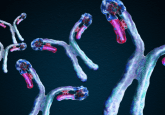Researchers develop rapid medical testing using Faraday rotation spectroscopy

The principle of Faraday rotation, a magnetic phenomenon discovered in 1845, is being combined with nanoscience to develop rapid medical tests. The research is being carried out by scientists at University of Central Florida (UCF; FL, USA).
The magneto-optical technique, called frequency-domain Faraday rotation spectroscopy—or fd-FRS, is being used by the team to characterize proteins, using antibody-functionalized magnetic nanoparticles (MNPs).
“Fd-FRS is a new way of looking at the interaction between light and magnetized material,” states Shawn Putnam, Assistant Professor at UFC’s College of Engineering & Computer Science. “We covered the surfaces of magnetic nanoparticles with a layer of biological sensors and measured their movement after exposure to their corresponding biological targets for detection.”
Putnam was able to read the nanoparticles’ Faraday rotation by applying a magnetic field and a light source to a sample. He said that information into how many bio-targets have been bound to the particle surface is given by how “sluggish” the particles become as they attempt to align with the alternating magnetic field.
“Combining magnetic, optical and nanoparticle science and engineering for biosensor development is not a new approach,” Putnam says, “but the way we reformulated expertise from these areas into a faster, simpler and competitive characterization technique to join the repertoire of diagnostics available today definitely is.”
The team were able to get medical test results significantly faster and by a more simple method thanks to improved data analysis, lower sample volumes and more precise chemistry. These techniques were combined by the researchers to achieve the present results. “Additionally, we have used established molecular adsorption — or binding — models to more fully understand the physics behind this technique’s ability to sense targets,” Putnam says. “Fd-FRS facilitates more efficient diagnosis that medical laboratories can easily incorporate into their daily routines.”
Due to purification and incubation steps, currently available methods tend to be time consuming. “Fd-FRS is capable of high-capacity testing due to the small volumes necessary to get a response as well as drastically improved test turnaround times — about 30 minutes compared with about four hours for ELISA,” he says, noting that getting test results quickly is a priority in hospitals, where time is of the essence. “Moreover, our method has been shown to yield a broader detection range and increased sensitivity for a model protein target.”
The team will now validate the model effect seen with clinically actionable proteins, such as markers of disease and those used in hospital laboratory work-ups.
“With these results in hand, we would then be in a good position to test and improve our method in the hospital setting, adapting to the needs, workflow, and input of medical personnel,” Putnam says. “The approval process for medical tests presents some important hurdles to overcome, but for a non-invasive and effective method such as this, I would not be surprised to see fd-FRS in clinics around the world in just a few years.”
Source: Murdock RJ, Putnam SA, Das S, Gupta A, Chase ED, Seal S. High-Throughput, Protein-Targeted Biomolecular Detection Using Frequency-Domain Faraday Rotation Spectroscopy. Small, DOI: 10.1002/smll.201602862 (2017).





